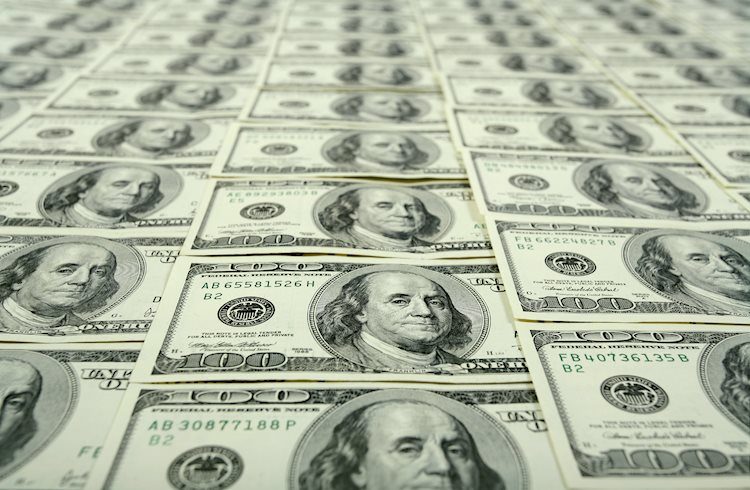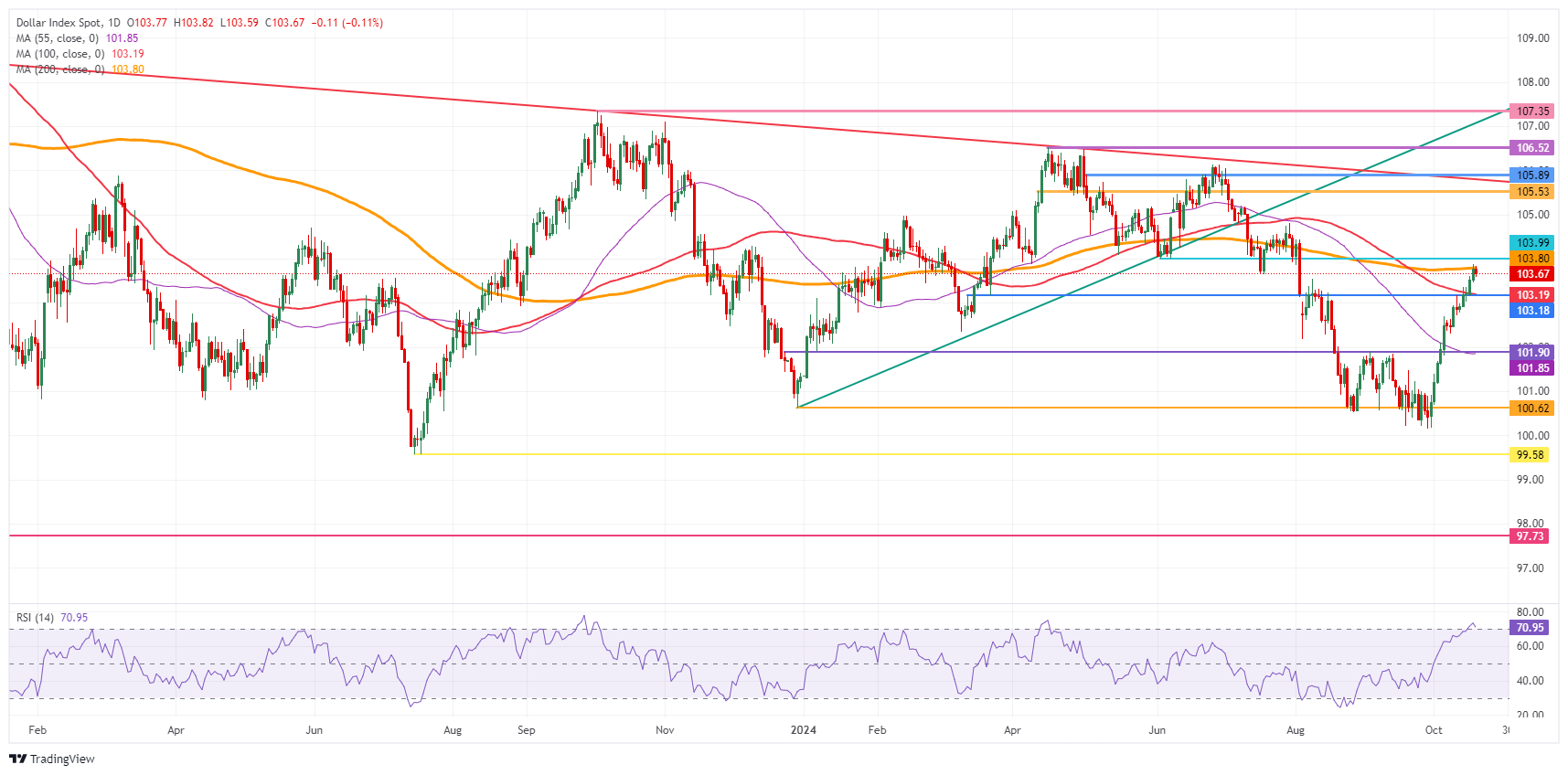
- The US Dollar fades a touch on Friday after a steep ride higher.
- Traders see China stepping up measures with deposit rate cuts and more stimulus details.
- The US Dollar Index rally looks to be halting for now, ahead of 104.00.
The US Dollar (USD) turns flat to a touch softer on Friday with some profit-taking after steep rallies against many major G20 currencies this week. The slight retracement comes on the back of Chinese economic data and more details on the stimulus package the Chinese government is rolling out. With Chinese deposit rates being cut this Friday and more details released on the Chinese stimulus package, it looks like China is propping up its economy further.
The US calendar is very light in terms of economic data. No real market-moving data points will be issued on Friday, with only Building Permits and Housing Starts on deck. Instead, look for the Federal Reserve (Fed), where no less than three members are set to speak.
Daily digest market movers: Does anyone still care about the Fed?
- At 12:30 GMT, the US Census Bureau will release housing data for September. Monthly Building Permits are expected to be at 1.46 million, compared to 1.47 million in August, while Housing Starts are expected to decrease to 1.35 million against 1.356 million prior.
- At 13:30 GMT, Federal Reserve Bank of Atlanta President Raphael Bostic delivers a presentation about economic education to high school students as part of the Mississippi Council on Economic Education Event.
- Around 14:00 GMT, Federal Reserve Bank of Minneapolis President Neel Kashkari moderates a policy panel at the 2024 Macroeconomic Policy Perspectives hosted by the Minneapolis Fed, the University of Chicago, and Stanford University.
- Near 16:10 GMT, Federal Reserve Governor Christopher Waller delivers a speech about decentralized finance at the Nineteenth Annual Vienna Macroeconomics Workshop in Vienna, Austria.
- At 16:30, Fed’s Bostic gives remarks and participates in a moderated conversation at the Mississippi Council on Economic Education’s Forum on American Enterprise luncheon, United States.
- Asian equities saw Chinese indices outperform on the extra wave of stimulus measures issued. European equities are trying to grasp European Central Bank President Christine Lagarde’s speech from Thursday on the sluggish European economy. US futures are flat on the day and are yet to choose a direction.
- The CME Fed rate expectation for the meeting on November 7 shows a 90.2% probability of a 25 bps rate cut, while the remaining 9.8% is pricing in no rate cut. Chances for a 50 bps rate cut have been fully priced out.
- The US 10-year benchmark rate is trading at 4.11% after having flirted with a break below 4% on Wednesday.
US Dollar Index Technical Analysis: This might be just the beginning
The US Dollar Index (DXY) sees the rally train come to a halt, with some better-than-expected Chinese data and measures taken by the Chinese government to support domestic demand. Though this rally might face a small fade, a big reversal does not seem to be in the cards. With the interest rate gap between the US, the Euro and other currencies widening again, the Greenback should at least remain supported towards the US elections in November.
A firm resistance ahead is 103.80, which aligns with the 200-day SMA. Above that, there is a small gap before hitting the pivotal level at 103.99 and the 104.00 big figure. Should Trump further lead in the polls, a rapid swing up to 105.00 and 105.53 could be on the cards.
On the downside, the 100-day SMA at 103.19 and the pivotal level at 103.18 are now acting as support and should prevent the DXY from falling lower. With the Relative Strength Index in overbought territory, a test on this level looks granted. Further down, the 55-day SMA at 101.85 and the pivotal level at 101.90 should avoid further downside moves.
US Dollar Index: Daily Chart
Risk sentiment FAQs
In the world of financial jargon the two widely used terms “risk-on” and “risk off” refer to the level of risk that investors are willing to stomach during the period referenced. In a “risk-on” market, investors are optimistic about the future and more willing to buy risky assets. In a “risk-off” market investors start to ‘play it safe’ because they are worried about the future, and therefore buy less risky assets that are more certain of bringing a return, even if it is relatively modest.
Typically, during periods of “risk-on”, stock markets will rise, most commodities – except Gold – will also gain in value, since they benefit from a positive growth outlook. The currencies of nations that are heavy commodity exporters strengthen because of increased demand, and Cryptocurrencies rise. In a “risk-off” market, Bonds go up – especially major government Bonds – Gold shines, and safe-haven currencies such as the Japanese Yen, Swiss Franc and US Dollar all benefit.
The Australian Dollar (AUD), the Canadian Dollar (CAD), the New Zealand Dollar (NZD) and minor FX like the Ruble (RUB) and the South African Rand (ZAR), all tend to rise in markets that are “risk-on”. This is because the economies of these currencies are heavily reliant on commodity exports for growth, and commodities tend to rise in price during risk-on periods. This is because investors foresee greater demand for raw materials in the future due to heightened economic activity.
The major currencies that tend to rise during periods of “risk-off” are the US Dollar (USD), the Japanese Yen (JPY) and the Swiss Franc (CHF). The US Dollar, because it is the world’s reserve currency, and because in times of crisis investors buy US government debt, which is seen as safe because the largest economy in the world is unlikely to default. The Yen, from increased demand for Japanese government bonds, because a high proportion are held by domestic investors who are unlikely to dump them – even in a crisis. The Swiss Franc, because strict Swiss banking laws offer investors enhanced capital protection.



